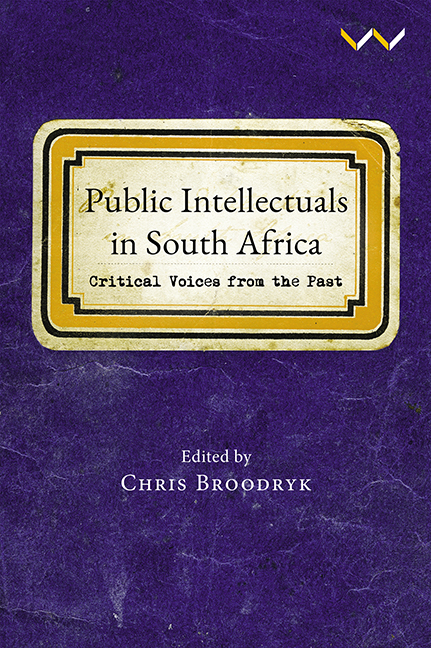Book contents
- Frontmatter
- Contents
- Acknowledgements
- Introduction: The Prismatic Nature of Public Intellectualism
- Chapter 1 Recalibrating the Deep History of Intellectual Thought in the KwaZulu-Natal Region
- Chapter 2 Elijah Makiwane and Early Black South African Public Intellectualism
- Chapter 3 Black Art Criticism in The Bantu World during the 1930s
- Chapter 4 In Conversation with the Nation: Sowetan’s Maverick Editor Aggrey Klaaste
- Chapter 5 William Pretorius and the Public Intellectualism of the Film Critic
- Chapter 6 Cultural Policy and the Arts: Mewa Ramgobin and Public Dialogue
- Chapter 7 ‘Kaalgat Critique’: The Public Intellectualism of Koos Roets as Afrikaans Satirist
- Chapter 8 The Public Intellectualism of Artivist Mandisi Sindo
- Chapter 9 The Janus-Faced Public Intellectual: Dr Thomas Duncan Greenlees at the Institute for Imbecile Children, 1895–1907
- Index
Chapter 3 - Black Art Criticism in The Bantu World during the 1930s
Published online by Cambridge University Press: 16 July 2022
- Frontmatter
- Contents
- Acknowledgements
- Introduction: The Prismatic Nature of Public Intellectualism
- Chapter 1 Recalibrating the Deep History of Intellectual Thought in the KwaZulu-Natal Region
- Chapter 2 Elijah Makiwane and Early Black South African Public Intellectualism
- Chapter 3 Black Art Criticism in The Bantu World during the 1930s
- Chapter 4 In Conversation with the Nation: Sowetan’s Maverick Editor Aggrey Klaaste
- Chapter 5 William Pretorius and the Public Intellectualism of the Film Critic
- Chapter 6 Cultural Policy and the Arts: Mewa Ramgobin and Public Dialogue
- Chapter 7 ‘Kaalgat Critique’: The Public Intellectualism of Koos Roets as Afrikaans Satirist
- Chapter 8 The Public Intellectualism of Artivist Mandisi Sindo
- Chapter 9 The Janus-Faced Public Intellectual: Dr Thomas Duncan Greenlees at the Institute for Imbecile Children, 1895–1907
- Index
Summary
David Nthubu Koloane was among the most accomplished black artists, curatorsand scholars of the twentieth century. Besides countless accolades fromaround the world, his contribution to South African art was immortalisedwhen he was awarded two honorary doctoral degrees by the Vaal University ofTechnology in 2008 and Rhodes University in 2015. In his now iconic article‘Art Criticism for Whom?’, Koloane argued that art criticismin South Africa was ‘ virtually non-existent’ outside thewhite art establishment. While Koloane's assertion was part of alarger political argument, his justifiable conclusion, which was echoed byother prominent scholars, has resulted in the history of black art criticismin South Africa being grossly under-researched. Contrary to this prevailingopinion, art criticism by black intellectuals has a rich heritage thatextends back to the early twentieth century during the founding of black-runpublications such as Ilanga lase Natal (established in the1900s), Umteteli wa Bantu (1920s) and The BantuWorld (1930s). These periodicals, written by black journalists,debated the nature and purpose of black art, while also appraising thecreative exploits of the formative black modern artists.
In this chapter I chronicle the early manifestations of black art criticismprinted in The Bantu World newspaper during the 1930s. Inthis introductory survey of the history of black art criticism in SouthAfrica, I show how art criticism existed as a public practice among theemergent black middle class. This public discourse was facilitated by andcatalogued in the leading black newspapers of the early twentiethcentury.
Steve Biko suggests that the ideal in any work of critical thinking is alwaysto begin by asking the right questions. When it comes to the question ofcriticism on the art made by black artists during the twentieth century,existing discourses have unwittingly arrived at conclusions – logicalas they may have been – that were predicated on a faulty set ofassumptions to begin with. Many of the pragmatic deductions regarding thehistory and nature of twentieth-century art criticism dealing with black artin South Africa measured it against the prevailing norms of Western artcriticism. This rubric was hugely problematic on two significant fronts.First, the material, educational and overall milieu that cultivated blackart in South Africa was vastly different from the situation in America andEurope throughout the twentieth century.
- Type
- Chapter
- Information
- Public Intellectuals in South AfricaCritical Voices from the Past, pp. 68 - 85Publisher: Wits University PressPrint publication year: 2021



